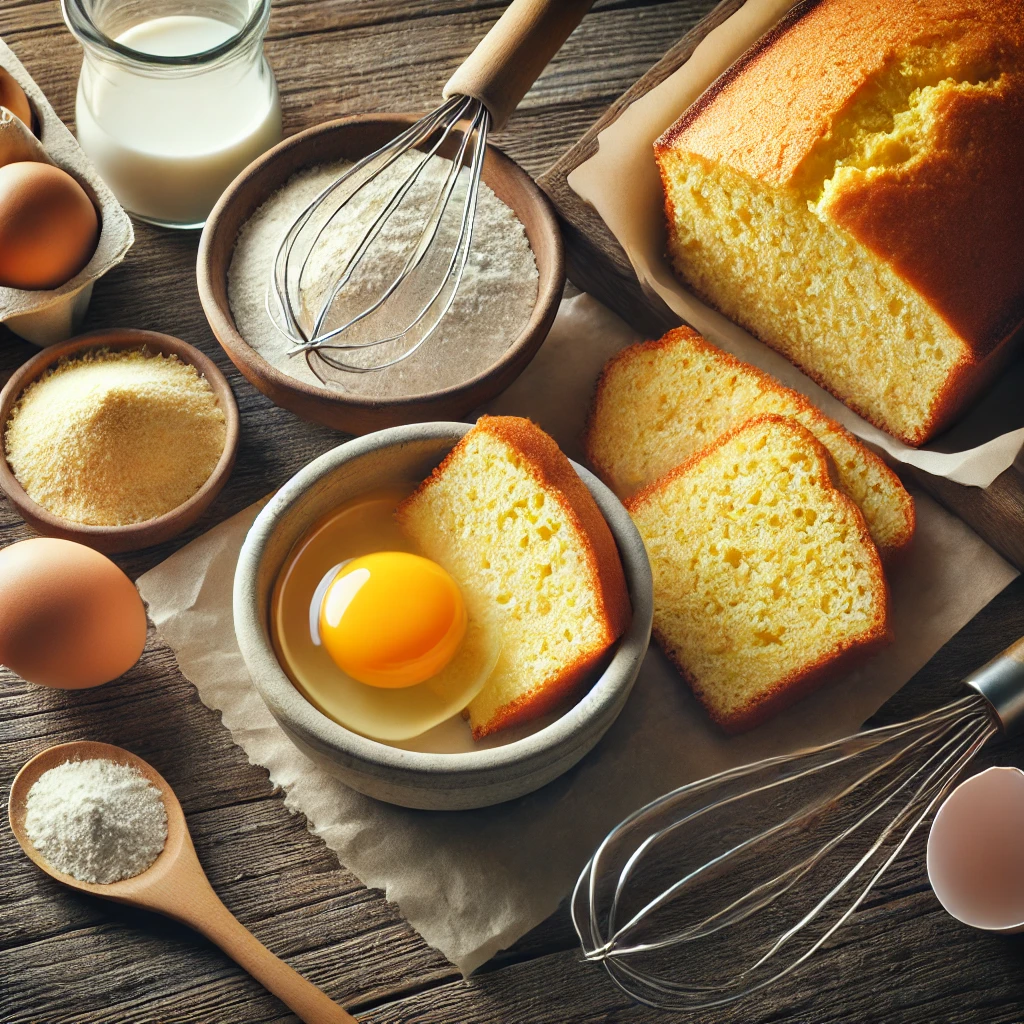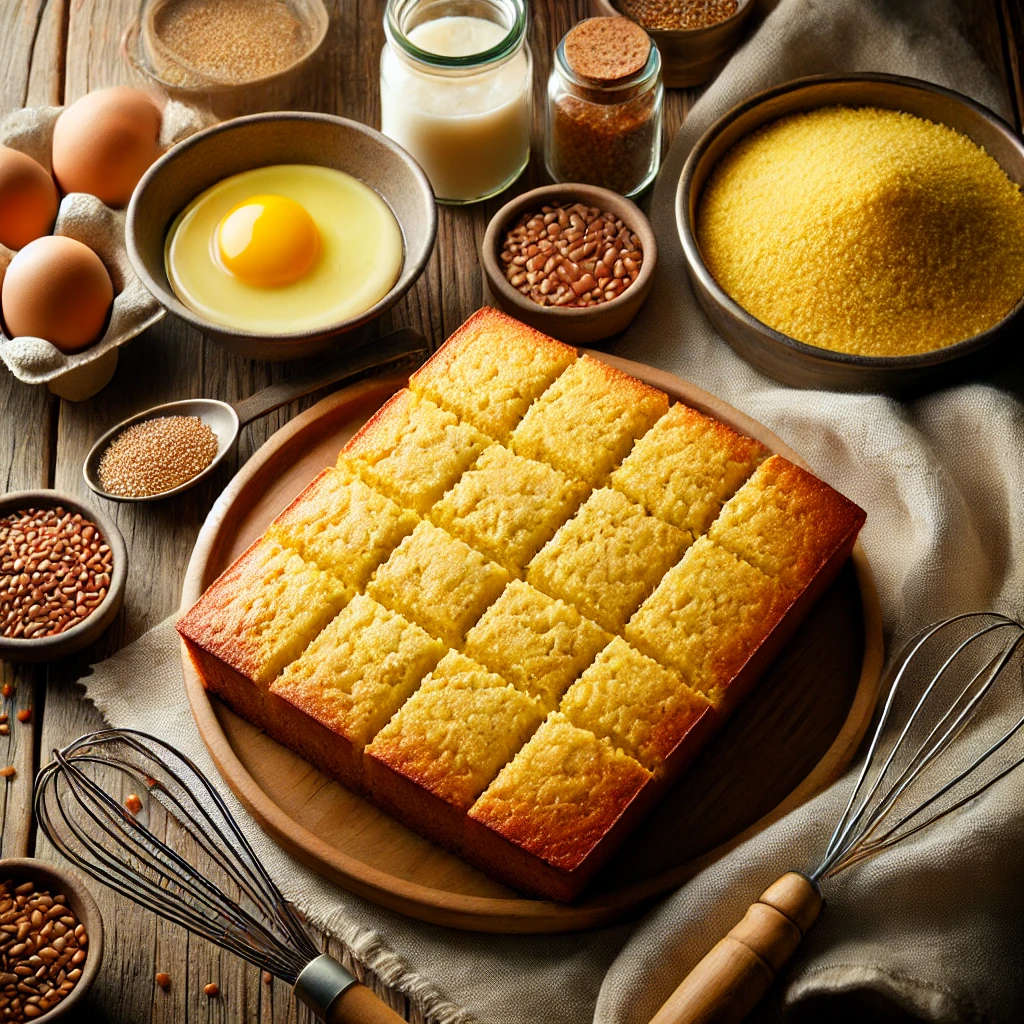Cornbread is a timeless favorite, loved for its crumbly texture, rich flavor, and versatility. But what if you skip the eggs? Whether you forgot to add them, ran out, or need an egg-free alternative, understanding how this affects your cornbread can help you adjust your recipe and still create a delicious result.
The Role of Eggs in Cornbread
Before we explore what happens without eggs, it’s essential to understand their role in cornbread. Eggs are multi-functional ingredients that impact several key aspects of the dish:
- Binding: Eggs help hold the batter together, preventing the cornbread from crumbling apart.
- Moisture: They add moisture, ensuring the cornbread stays tender and soft.
- Leavening: Eggs contribute to the cornbread’s rise, creating a light and fluffy texture.
- Flavor: They add richness, enhancing the overall taste of the cornbread.
When you skip eggs, you lose these benefits, but that doesn’t mean your cornbread is doomed!

What Happens When You Don’t Add Eggs?
Leaving eggs out of cornbread can lead to several noticeable changes:
1. The Texture Becomes Crumblier
Without eggs to bind the ingredients together, the cornbread may fall apart more easily. This crumbly texture can still be enjoyable, especially if you’re using it for stuffing or as a topping.
2. The Moisture Decreases
Eggs contribute to the moisture content in cornbread. Without them, the cornbread may turn out drier. This can be mitigated by adding other moist ingredients like yogurt, applesauce, or oil.
3. The Rise Is Limited
Eggs act as a leavening agent, helping the batter rise and become fluffy. Skipping eggs may result in a denser, flatter cornbread. Adding baking powder or soda can help compensate for this.
4. The Flavor Changes
Eggs add richness and depth of flavor. Without them, the cornbread may taste slightly less indulgent. Incorporating flavorful ingredients like butter, cheese, or spices can enhance the taste.
How to Make Egg-Free Cornbread That Tastes Great
If you’re intentionally skipping eggs or need a substitute, there are plenty of ways to achieve delicious results:
1. Use an Egg Substitute
There are many alternatives to eggs that can replicate their role in cornbread:
- Flaxseed or Chia Seeds: Mix 1 tablespoon of ground flaxseed or chia seeds with 3 tablespoons of water. Let it sit for 5 minutes to form a gel-like consistency.
- Applesauce: Replace each egg with ¼ cup of unsweetened applesauce for moisture and binding.
- Mashed Banana: Use ¼ cup of mashed banana per egg for sweetness and binding.
- Yogurt: Replace eggs with ¼ cup of plain yogurt (dairy or plant-based) for moisture and richness.
- Baking Powder and Oil: Mix 2 tablespoons of water, 1 tablespoon of oil, and 2 teaspoons of baking powder for leavening and binding.
2. Add Extra Moisture
Since eggs contribute to moisture, replace them with liquid-rich ingredients like milk, buttermilk, or plant-based milk to ensure the cornbread isn’t too dry.
3. Boost the Leavening
Increase the amount of baking powder or soda in your recipe to help the cornbread rise. A general guideline is to add ½ teaspoon of baking powder per cup of flour.
4. Enhance the Flavor
Incorporate flavorful ingredients to make up for the richness eggs provide. Options include:
- Melted butter or coconut oil for richness.
- Honey or maple syrup for sweetness.
- Herbs, spices, or shredded cheese for savory cornbread.
Common Questions About Cornbread Without Eggs
1. Can I still achieve a fluffy texture without eggs?
Yes, by using leavening agents like baking powder or soda and adding carbonated water, you can create a light and fluffy texture.
2. Will my cornbread fall apart without eggs?
It may be crumblier, but using a strong binder like flaxseed meal or yogurt can help it hold together.
3. Does egg-free cornbread taste different?
The flavor will be slightly less rich, but adding ingredients like butter, cheese, or spices can enhance the taste.
4. Can I make cornbread without any substitutes?
Yes, but the result will likely be drier and crumblier. Adding extra fat (like oil) or moisture (like milk) can help balance the texture.
5. What’s the best egg substitute for cornbread?
Flaxseed or chia seeds are excellent for binding, while applesauce or yogurt adds moisture and richness.
Pros and Cons of Egg-Free Cornbread
Pros
- Suitable for vegans or those with egg allergies.
- Easy to customize with substitutes and flavors.
- Still delicious with the right adjustments.
Cons
- Can be drier or crumblier without careful substitution.
- May require extra leavening for fluffiness.
- Slightly different flavor profile.

Conclusion
Skipping eggs in cornbread is entirely possible and can still result in a delicious dish. While eggs play an important role in texture, moisture, and flavor, creative substitutions like flaxseed, yogurt, or applesauce can replicate these qualities effectively. With a few adjustments, you can make egg-free cornbread that’s just as satisfying and versatile as the traditional version.
Whether you’re avoiding eggs for dietary reasons or experimenting with new recipes, egg-free cornbread is a tasty and adaptable option for every occasion.
How to Make Cornbread Without Eggs
Egg-free cornbread isn’t just a workaround for missing ingredients—it’s an opportunity to create a delicious, customized dish. Let’s dive deeper into how to prepare the perfect cornbread without eggs.
Step-by-Step Instructions for Egg-Free Cornbread
1. Choose Your Egg Substitute
Selecting the right egg replacement is crucial. Consider the following options based on your desired texture and flavor:
- Flaxseed Meal or Chia Seeds: Great for binding and adding a nutty flavor.
- Applesauce or Mashed Banana: Perfect for sweet, moist cornbread.
- Yogurt or Buttermilk: Excellent for a creamy, rich texture.
- Baking Powder and Oil Mixture: Ideal for light and fluffy cornbread.
2. Adjust the Ingredients
- Increase the leavening agents slightly (e.g., baking powder or soda) to compensate for the eggs’ role in rising.
- Adjust the liquid content to ensure the batter is moist but not overly runny.
3. Preheat Your Oven and Pan
- Preheat your oven to 375°F (190°C).
- If using a cast-iron skillet, place it in the oven while it preheats. A hot skillet ensures a crispy crust.
4. Mix Dry and Wet Ingredients Separately
- Dry Ingredients: Combine cornmeal, flour, baking powder, salt, and sugar (if desired) in a large bowl.
- Wet Ingredients: Mix your egg substitute with milk, oil, and any additional flavorings in a separate bowl.
5. Combine Gently
Pour the wet ingredients into the dry ingredients and stir until just combined. Avoid overmixing to prevent dense cornbread.
6. Bake to Perfection
- Pour the batter into a greased skillet, baking dish, or muffin tin.
- Bake for 20–25 minutes, or until a toothpick inserted into the center comes out clean.
7. Serve and Enjoy
Let the cornbread cool for a few minutes before slicing. Serve with butter, honey, or your favorite toppings.
Tips for Making Better Egg-Free Cornbread
- Don’t Skip the Fat
Eggs contribute to the richness of cornbread, so ensure you’re adding enough fat, such as oil or butter. - Experiment with Substitutes
Different substitutes can create unique textures and flavors. For example:- Flaxseed for hearty, nutty cornbread.
- Applesauce for sweetness and moisture.
- Yogurt for a creamy, tangy profile.
- Preheat Your Baking Dish
A hot skillet or pan creates a crisp crust, a signature characteristic of Southern-style cornbread. - Taste Test Your Batter
Adjust the sweetness or seasoning before baking to ensure it’s just right.
Egg-Free Cornbread Variations
Once you master the basics, try these creative variations:
1. Sweet Cornbread
- Substitute eggs with applesauce or mashed banana for added sweetness.
- Add 2 tablespoons of honey or maple syrup to the batter.
- Serve with a drizzle of honey or a dollop of whipped butter.
2. Savory Cornbread
- Use flaxseed or yogurt as an egg substitute for a neutral flavor.
- Mix in diced jalapeños, shredded cheese, or chopped green onions.
- Pair with hearty stews or chili.
3. Gluten-Free Cornbread
- Replace all-purpose flour with a gluten-free baking mix.
- Use chia seeds or flaxseed meal as the egg substitute.
- Add a touch of honey for extra flavor.
4. Mini Cornbread Muffins
- Make individual servings by baking in a muffin tin.
- Use carbonated water as an egg replacement for a lighter texture.
- Perfect for portion-controlled sides or snacks.
How to Enhance Flavor Without Eggs
Egg-free cornbread can sometimes lack the richness eggs provide. Here’s how to amp up the flavor:
- Use Buttermilk: Adds tanginess and moisture.
- Incorporate Herbs and Spices: Fresh rosemary, thyme, or paprika can elevate savory cornbread.
- Add Sweeteners: Honey, molasses, or brown sugar add depth to sweet cornbread.
- Include Mix-Ins: Try corn kernels, nuts, or dried fruit for added texture and taste.
Storing and Reheating Egg-Free Cornbread
Proper storage ensures your cornbread stays fresh and delicious:
1. Storage Tips
- Room Temperature: Wrap in foil or store in an airtight container for up to 2 days.
- Refrigeration: Extend freshness by storing in the fridge for up to a week.
- Freezing: Wrap individual slices in plastic wrap and freeze for up to 3 months.
2. Reheating Tips
- Oven: Wrap cornbread in foil and heat at 350°F for 10–15 minutes.
- Microwave: Warm individual slices for 15–20 seconds for a quick snack.
Pro Tip: Brush with butter before reheating to restore moisture.
Common Questions About Egg-Free Cornbread
1. Can I Make Cornbread Without Any Egg Substitutes?
Yes, but it may be drier and more crumbly. Adding extra fat or moisture can improve the texture.
2. Will Egg-Free Cornbread Taste Different?
The flavor will be slightly less rich, but you can compensate by using flavorful ingredients like butter, spices, or sweeteners.
3. Can I Use Store-Bought Egg Replacers?
Absolutely! Commercial egg replacers are a reliable option and mimic eggs’ properties effectively.
4. What’s the Best Vegan Egg Substitute for Cornbread?
Flaxseed meal and chia seeds are great vegan options, as they provide binding and a neutral flavor.
5. Can I Make Cornbread Gluten-Free and Egg-Free?
Yes! Use a gluten-free flour blend and a vegan egg substitute like flaxseed meal or chia seeds for a delicious result.
Egg-free cornbread doesn’t just work—it shines with the right techniques and substitutes. By following these steps and experimenting with variations, you can create a flavorful, moist, and satisfying cornbread that suits any dietary need or occasion

